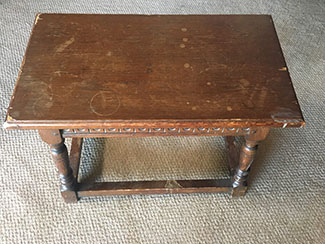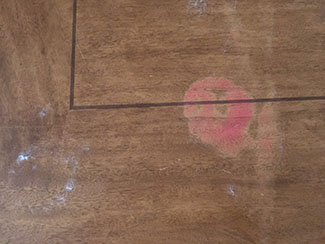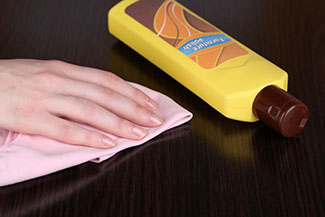Restoring the Life Of Wood Furniture
Oiling/restoring wood furniture after guests visit
After the holidays are over and the guests leave, you may notice that things look a little worse for wear. The coffee and end tables have water rings. There are new scratches on the dining table. There are cigarette burns and residue on the nightstand and dresser. Depending on the extent of the damage, you may be able to restore the furniture yourself.
Rosie on the House Certified Partner, Irwin's Furniture Restoration, offers the following tips to restore your wood furniture.
First, vacuum the area so you have a clean area to work with. Using a 100 percent cotton or soft microfiber cloth, dab it with a light amount of furniture oil. Donald Irwin, Jr., operations manager of Irwin's, says one of the worst things people do when trying to clean or restore their wood is using cloths or pads that are abrasive and scratch finishes.
"It's best to only use 100 percent cotton cloth and always wipe in the direction of the grain," said Irwin. "Do not use heavy hand pressure if there is a heavy layer of dust particles as they will scratch the finish. Wipe off lightly with a damp soft cloth to remove debris. Then go back over with furniture oil."

Irwin recommends using a brand name pure oil such as Mohawk, Old English, and Guardsman to clean and dust rather than an aerosol polish in a can. "Aerosol products contain added chemicals, which are harmful to your furniture's finish," said Irwin.
Specific Damage
Water Rings & Heat Marks
White hazy or cloudy areas are caused by setting a hot food container directly on the table. Saturate a cloth with lemon oil. Place it on the water stain overnight, or even 24 hours. For very deep marks, leave it on for 48 hours. The lemon oil will work the moisture out of the lacquer finish. If the water ring is stubborn, use a blush eraser as the next step. A blush eraser is a retarder that is sprayed or misted on the area. While it is effective from a home remedy standpoint, it may not remove the mark 100 percent.
Cigarette, Cigar & Other Smoking Odors & Stains
Smoke is greasy. Water will not remove smoke stains or odors. Odorless mineral spirits is a great degreaser. There are several brands to choose from. Unless the manufacturer's instructions say otherwise, lightly dampen a cotton cloth and gently wipe surfaces to cut through smoke residue.
Scratches & Chips
 Gluing may be the right repair method for large chips or breaks. But it requires driving the glue deep into the pores of the wood under clamp pressure to build a "bridge" bond. "When customers simply squirt a glob of glue into a joint, all they accomplish is closing all the pores of the wood. It's nearly impossible to follow them with a proper repair without adding a lot of work to undo their work to make the wood repairable again," said Irwin.
Gluing may be the right repair method for large chips or breaks. But it requires driving the glue deep into the pores of the wood under clamp pressure to build a "bridge" bond. "When customers simply squirt a glob of glue into a joint, all they accomplish is closing all the pores of the wood. It's nearly impossible to follow them with a proper repair without adding a lot of work to undo their work to make the wood repairable again," said Irwin.
Keeping It Pristine
Once you have restored your wood furniture, Irwin suggests the following tips to keep them looking their best.
- Keep a pure oil product around for routine cleaning and dusting.
- Wood furniture in our dry, dusty Arizona climate requires special care. Keep fine wood pieces away from direct sunlight such as windows as much as possible. Clean and oil wood furniture every 3 months with a quality name brand pure furniture oil. Purchase an oil product that "pours" out of a bottle, not one that sprays out in a mist. Teak, lemon, citrus, and tongue oil work well.
- Do NOT place warm dishes or iced drinking glasses directly on wood tabletops. Condensation will be absorbed into the finish causing discoloration and damage. Always use coasters, placemats, and hot pads - some type of protective barrier between a hot dish (or pizza box) and the tabletop finish. Anything that will prevent a buildup of condensation from penetrating into the finish and causing a permanently cloudy appearance.
- Never leave a plastic tablecloth on your table long term. The petroleum distillates in the plastic will "outgas" into the finish and permanently soften it. Vinyl-covered books and rubber pads under staplers and calculators will yield the same result.
- Avoid storing cosmetics on wood furniture. Many cosmetics, especially nail polish remover, will quickly dissolve away the finish down to the wood. Once this occurs, the only corrective action is to refinish the entire flat top surface of the furniture.
- Keep your pets' nails trimmed. Clean up pet mishaps right away so the ammonia and enzymes do not settle into the wood.
- Wipe up wet spills quickly. Use a barely damp towel. Do not use a vacuum with a beater bar (the rotating brush unit within the powerhead of a vacuum cleaner) as it can damage the wood.

Oils: Same, But Different
Lemon, citrus, tongue and teak oil are made from plant resins. Viscosity is what makes them different. Irwin recommends Mohawk, Old English, and Guardsman products. Fluid oil is recommended for maintaining wood products inside the home.
Irwin notes that Murphy's Oil Soap has petroleum distillates in it which will soften older shellac finishes that have already started to breakdown from age. "Some added elbow grease and you're on your way to actually removing your finish from the wood," said Irwin.
There are organic cleaners that use concentrated essential oils that work as furniture strippers when not diluted or used as directed. "We have actually had to refinish a couple of tables this year due to people overusing these products and removing portions of their finishes," said Irwin.
Follow these simple steps and remedies to keep your wood furniture looking new for generations to come.
Home Maintenance To-Do | #FurnitureCare
###
Photo Credits:
- Rosie on the House
- Shutterstock
RELATED CONTENT:
- Blog: 7 Things to Know About When Buying Patio Furniture
- DIY FAQ: How Can I Protect My Wooden Deck & Patio
- DIY FAQ: How Do I Care For My Leather Furniture?
- DIY FAQ: How Do I Finish Wood?
- DIY FAQ: How Can I Remove Nail Polish That Spilled On My Wood Floor?
- DIY FAQ: Why have My Wood Floors Changed Color?
- DIY FAQ: How Can I Keep My Wood or Laminate Floors Looking Nice?
- Podcast: Furniture Restoration
